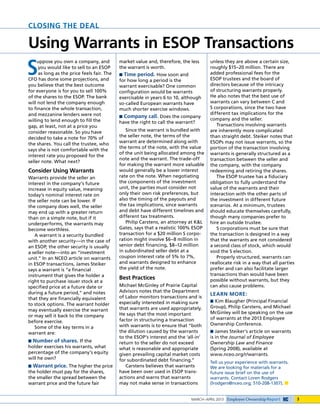
Using Warrants in ESOP Transactions
- 1. Closing the Deal Using Warrants in ESOP Transactions S uppose you own a company, and you would like to sell to an ESOP as long as the price feels fair. The CFO has done some projections, and you believe that the best outcome for everyone is for you to sell 100% of the shares to the ESOP. The bank will not lend the company enough to finance the whole transaction, and mezzanine lenders were not willing to lend enough to fill the gap, at least, not at a price you consider reasonable. So you have decided to take a note for 70% of the shares. You call the trustee, who says she is not comfortable with the interest rate you proposed for the seller note. What next? Consider Using Warrants Warrants provide the seller an interest in the company’s future increase in equity value, meaning today’s nominal interest rate on the seller note can be lower. If the company does well, the seller may end up with a greater return than on a simple note, but if it underperforms, the warrants may become worthless. A warrant is a security bundled with another security—in the case of an ESOP, the other security is usually a seller note—into an “investment unit.” In an NCEO article on warrants in ESOP transactions, James Steiker says a warrant is “a financial instrument that gives the holder a right to purchase issuer stock at a specified price at a future date or during a future period,” and notes that they are financially equivalent to stock options. The warrant holder may eventually exercise the warrant or may sell it back to the company before exercise. Some of the key terms in a warrant are: ■■ Number of shares. If the holder exercises his warrants, what percentage of the company’s equity will he own? ■■ Warrant price. The higher the price the holder must pay for the shares, the smaller the spread between the warrant price and the future fair market value and, therefore, the less the warrant is worth. ■■ Time period. How soon and for how long a period is the warrant exercisable? One common configuration would be warrants exercisable in years 6 to 10, although so-called European warrants have much shorter exercise windows. ■■ Company call. Does the company have the right to call the warrant? Since the warrant is bundled with the seller note, the terms of the warrant are determined along with the terms of the note, with the value of the unit being allocated among the note and the warrant. The trade-off for making the warrant more valuable would generally be a lower interest rate on the note. When negotiating the components of the investment unit, the parties must consider not only their own risk preferences, but also the timing of the payouts and the tax implications, since warrants and debt have different timelines and different tax treatments. Philip Carstens, an attorney at K&L Gates, says that a realistic 100% ESOP transaction for a $20 million S corporation might involve $6–8 million in senior debt financing, $8–12 million in subordinated seller debt at a coupon interest rate of 5% to 7%, and warrants designed to enhance the yield of the note. Best Practices Michael McGinley of Prairie Capital Advisors notes that the Department of Labor monitors transactions and is especially interested in making sure that warrants are used appropriately. He says that the most important factor in structuring a transaction with warrants is to ensure that “both the dilution caused by the warrants to the ESOP’s interest and the ‘all-in’ return to the seller do not exceed what is reasonable and appropriate given prevailing capital market costs for subordinated debt financing.” Carstens believes that warrants have been over used in ESOP transactions and warns that warrants may not make sense in transactions unless they are above a certain size, roughly $15–20 million. There are added professional fees for the ESOP trustees and the board of directors because of the intricacy of structuring warrants properly. He also notes that the best use of warrants can vary between C and S corporations, since the two have different tax implications for the company and the seller. Transactions involving warrants are inherently more complicated than straight debt. Steiker notes that ESOPs may not issue warrants, so the portion of the transaction involving warrants is generally structured as a transaction between the seller and the company, with the company redeeming and retiring the shares. The ESOP trustee has a fiduciary obligation to fully understand the value of the warrants and their interaction with the other parts of the investment in different future scenarios. At a minimum, trustees should educate themselves carefully, though many companies prefer to hire an outside trustee. S corporations must be sure that the transaction is designed in a way that the warrants are not considered a second class of stock, which would void the S election. Properly structured, warrants can reallocate risk in a way that all parties prefer and can also facilitate larger transactions than would have been possible without warrants, but they can also cause problems. Learn more: ■■ Kim Blaugher (Principal Financial Group), Philip Carstens, and Michael McGinley will be speaking on the use of warrants at the 2013 Employee Ownership Conference. ■■ James Steiker’s article on warrants is in the Journal of Employee Ownership Law and Finance (Spring 2008), available at www.nceo.org/r/warrants. Tell us your experience with warrants. We are looking for materials for a future issue brief on the use of warrants. Contact Loren Rodgers (lrodgers@nceo.org; 510-208-1307). n March–April 2013 Employee Ownership Report 3
